
Category: Audio Gear, etc.
Common-sense stereo-system advice from a record producer/engineer.
Sound Devices USBPre 2 as a Location-Live Recording Interface
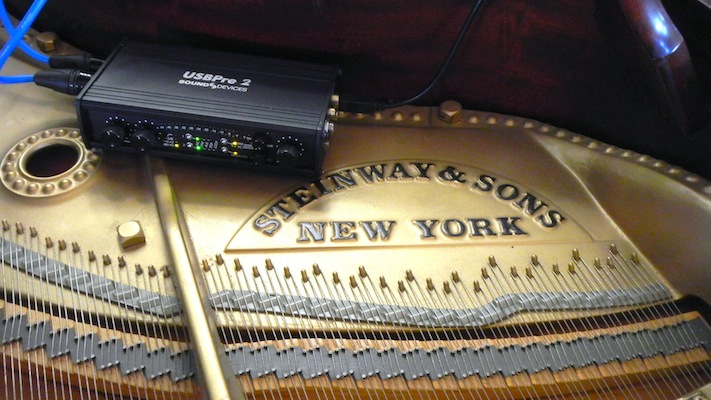
As part of my series on making digital transfers of vinyl LP phono records, I recommended Sound Devices’ USBPre 2 (street price $895) as the most cost-effective (“Pareto Optimal”) USB combination analog-to-digital converter and monitor (headphones or loudspeakers) controller. In that usage, the USBPre 2 takes an analog output from a phono stage through its line-level RCA jacks and converts the analog signal to digital (at data densities up to 24 bits/192kHz), and outputs the digital datastream via USB cable to a host computer (which is also the source of the USBPre 2’s power). The linked-to blog post enumerates the USBPre 2’s many virtues, and makes a compelling case for its value for money.
In addition to digitizing LPs, the USBPre 2 can be used for live recording. The USBPre 2 can provide 48V “phantom” power to professional microphones (but the 48V power can be switched off for pure-ribbon or dynamic microphones). Further, the USBPre 2’s metering and monitoring are truly professional-class. Given that the USBPre 2’s microphone preamplifiers are based on those of Sound Devices’ industry-standard 700 Series remote-location portable digital recorders, I wanted to make a location-live solo-piano recording. More details, and a sound sample, after the jump. Continue Reading →
In Memory of Richard Shahinian, 1931 – 2017
In memory of music lover and loudspeaker designer Richard “Dick” Shahinian, I offer a very impressive live performance of Mozart’s Requiem, by the French vocal ensemble Arsys Bourgogne with the Camerata Salzburg. Aside from faith and family, Dick’s major passion in life was large-scale orchestral music (or large-scale works for orchestra and chorus). The larger the scale, the better, it seemed. During one audio show, I asked Dick to play on his demo system a track I had brought with me, a live recording of Jessye Norman singing the Angel’s Farewell from Elgar’s The Dream of Gerontius. After the track had played, Dick allowed that it was all fine and good; but then he asked me why had I not played the Demons’ Chorus, instead? That’s Dick in a nutshell—unusually knowledgeable about even the most obscure musical works, and… very opinionated.
Dick’s love affair with classical music began at age 14, with the birthday present of a 78-rpm phonograph and a recording of Gershwin’s Rhapsody in Blue. About a year later (1946), at Carnegie Hall, Dick heard the New York Philharmonic play Richard Strauss’ Metamorphosen and Bruckner’s Eighth Symphony, conducted by Bruno Walter. Years later, Dick wrote, “I have never quite recovered from the shattering impact of that experience.”
After serving honorably in the United States Marine Corps, from the late 1950s on (the blossoming of the Golden Age of Hi-Fi), Dick devoted his career to bringing the thrill of live orchestral music into peoples’ homes (to the greatest extent possible, that is) by advancing the art of loudspeaker design. For more, please click on the jump link. Continue Reading →
In Memory of Charles Hansen, 1956-2017
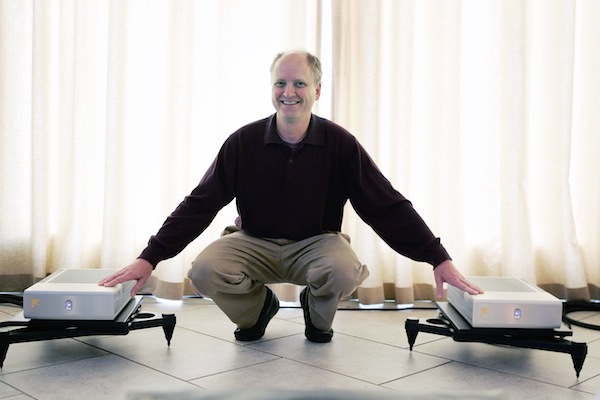
Audiac Persdag 26-04-2006
Foto en © Jiri Büller
The small world of high-end audio is reeling from the untimely and unexpected death of Charles Hansen, who was the chief designer of Avalon Loudspeakers before striking out on his own to found Ayre Acoustics. Ayre Acoustics’ announcement concludes with the request that those who remember him, at some time over the coming holidays, play an album in memory of Charley. I am sure that I will do that.
As a reviewer for Stereophile magazine and then as a consultant for the University of the South’s Ralston Listening Library (the audio system of which, in its first incarnation, included Ayre amplifiers driving Wilson Audio’s Alexandria II loudspeakers), I got to know Charley, and to appreciate his passion for musical truth, and truth in general.
Charley Hansen was a good man and a devoted father. He had a vibrant interest in education of all kinds, but especially music education. If I recall correctly, he was a supporter of Waldorf education, and I know he was very proud of his child the student violinist. After an irresponsible person nearly ended but surely blighted Charley’s life, I always continued to marvel at his equanamity and grace.
I will miss him.
I know that Charley loved violin music, because he once asked me to send him some JMR CDs by Arturo Delmoni, and then he insisted on paying for them.
So, in memory of Charley, I offer my music video “Wally the Finch Listens to Hlif Sigurjonsdottir Play Bach.”
# # #
A Pair of Bose 901s in a 21st-Century California Home
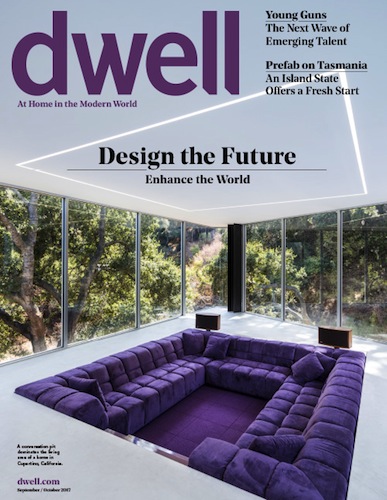
It took me a moment to realize that the loudspeakers behind the conversation pit of the 21st-century California home that is the subject of the cover story of the September/October issue of Dwell magazine were venerable Bose 901s.
I not only bought the issue; I took out a subscription.
Dwell‘s cover-story house (Craig Steely, architect) will not appear on the cover of This Old House, at least any time soon. (Give it 100 years.) Very cutting-edge in its details, such as the curved corners of the glass walls and the LED ceiling strip lights that set off different areas, the house nonetheless adheres firmly to the Mid-Century-Modern precept of siting the home within nature, rather than in opposition to it. The first similar design was Mies van der Rohe‘s see-though glass-walled Farnsworth House, built for Dr. Edith Farnsworth.
OK… But–how did the 901s get into a 21st-century house?
For that, some background on the 901, and my thoughts about the architectural-acoustical aspects of the design, please click the jump link. Continue Reading →
Vintage SME 3009 Tone Arm Rebuild, Part 1
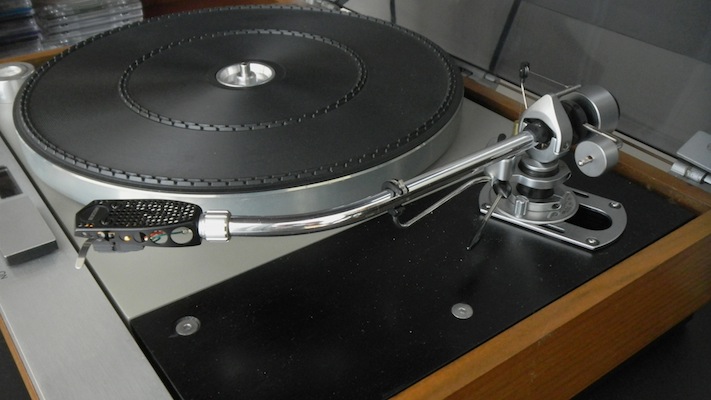
My music-loving friend who upgraded his Bricasti M1 to the gold-plated edition wanted to be able to continue to listen to Long-Playing vinyl phonograph records. However, while Bricasti’s M12 Source Controller does have a set of analog inputs, the M1 does not.
I suppose I should now insert a Heresy Trigger Warning Alert, in that I believe that in most cases, LPs are not really a high-resolution format–compared to anything as good as or better than native 20-bit 44.1kHz PCM. So I chose the expedient but gratifyingly effective path of specifying an affordable Analog to Digital Converter that I surmise was made for the Custom Installation market, the now-discontinued Key Digital AXXDA, for the princely sum of $50. That unit is based on a 24-bit, 48kHz chip.
Click on the jump link to hear the surprisingly good results from a MoFi vintage Frank Sinatra 180-gram remastering! Continue Reading →
Frank Sinatra’s Hi-Fi, circa 1947
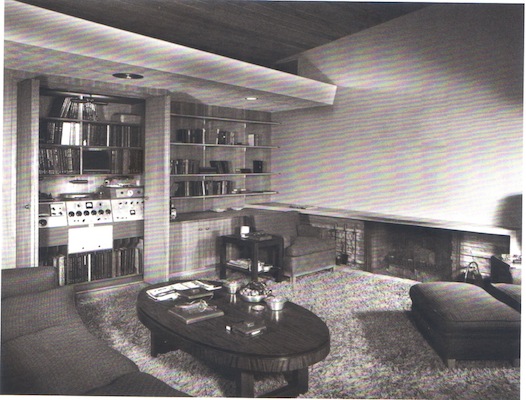 Photographed in 1949 by Julius Shulman.
Photographed in 1949 by Julius Shulman.
Julius Shulman: Modernism Rediscovered (3 vols.)
Directed and Produced by Benedikt Taschen
Taschen, Cologne, 2016
Vol. 1: 336 pp.; 15.5 x 10.5 x 1.5 inches; 19 pounds total weight for set.
Frank Sinatra signed with Colombia Records in 1943. However, wartime rationing meant that only the so-called “V-Discs” (“Victory Discs”) that were recorded as morale boosters for service personnel overseas could be manufactured. Regular commercial recording resumed only after the end of the war. The Voice of Frank Sinatra, Sinatra’s first “album” of four 78rpm records, was released in March 1946, having been recorded in two sessions on July 30 (Hollywood) and December 7 (New York) 1945. The Voice of Frank Sinatra went to the top of the Billboard chart, and stayed at No. 1 for seven weeks.
Ironically enough, though, it was Sinatra’s contract with movie studio MGM that provided him his first million dollars, enabling him in 1947 to hire architect E. Stewart Williams. At first, Sinatra had wanted a Georgian mansion, complete with brick façade and white columns. But Williams was able to convince Sinatra that the Palm Springs location called for a different style. As you can see above, when originally built, the Sinatra House housed a state-of-the-art 78rpm hi-fi system. Continue Reading →
Audio-Technica ATH-M50x Headphones
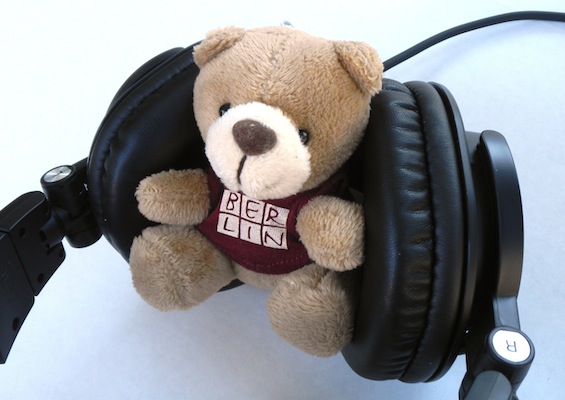
Berlin the Bear says, “Body-Shaking Bass!!!”
This is the sixth (and final) installment in my series about choosing Pareto-Optimal equipment to make archival digital copies of vinyl LP (long-playing) phonograph records. The first part (an overview) is here. Part 2 (Rega’s Planar 3 turntable package) is here. Part 3 (Graham Slee’s Revelation M phono stage) is here. Part 4 (a USB computer interface to handle analog-to-digital conversion) is here. Part 5 (software to make and edit a digital transfer of an analog LP) is here. This installment is about choosing headphones and monitoring loudspeakers for digitizing legacy media formats.
In much the same way that one cannot go wrong buying paint from Benjamin Moore (there probably are “better” paints; but, for most people and most uses, Benjamin Moore is the Pareto-Optimal choice), one cannot go wrong buying Audio-Technica’s ATH-M50x headphones. Their virtues include (as far as I know) class-leading sound in their very affordable price tier (in Basic Black, $149 with free shipping from B&H Photo); closed-back earcup design for two-way sound isolation; comfort; and robust construction.
Part of my calculus is that for the limited purposes of ripping and editing an LP, headphones (or monitoring loudspeakers) that are good enough, will be good enough. For an elaboration of that, and other headphone options and loudspeaker options, please click on the jump link. Continue Reading →
Hairersoft Amadeus Pro 2 Editing and Mastering Software
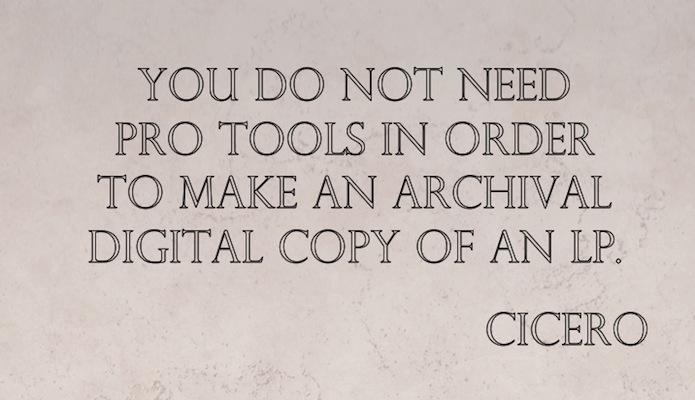
This is the fifth (and the penultimate) installment in my series about choosing Pareto-Optimal equipment to make archival digital copies of vinyl LP (long-playing) phonograph records. The first part (an overview) is here. Part 2 (Rega’s Planar 3 turntable package) is here. Part 3 (Graham Slee’s Revelation M phono stage) is here. Part 4 (a USB computer interface to handle analog-to-digital conversion) is here. This installment covers software to make and edit a digital transfer of an analog LP.
In my immediately-previous installment, I tried to drive home the point that the kind of “computer audio interface” box that you can find at your local guitar-and-keyboards store is likely to have features you don’t need, while lacking features that you do need. This installment sings the same tune, but with different words.
You do not need the Pro Tools software suite in order to make an archival-quality digital transfer of an LP (or any other legacy sound-media format). (Neither do you need a lightning-fast tower computer with buckets of RAM.) Justifications, after the jump. Continue Reading →
Sound Devices USBPre 2 Portable High-Resolution Audio Interface
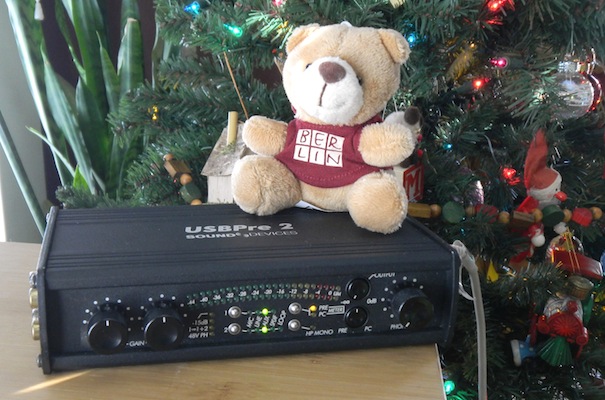 Berlin the Bear celebrates Christmas with some great audio gear! Photo by John Marks
Berlin the Bear celebrates Christmas with some great audio gear! Photo by John Marks
This is the fourth installment in my series about choosing Pareto-Optimal equipment to make archival digital copies of vinyl LP (long-playing) phonograph records. The first part (an overview) is here. Part 2 (Rega’s Planar 3 turntable package) is here. Part 3 (Graham Slee’s Revelation M phono stage) is here. This installment covers the conversion of the analog signal from the phono stage into a digital-audio data file.
Unfortunately, as far as I have been able to determine, the various inexpensive solutions for making digital transfers of LPs are inadequate for making archival-quality copies. In this regard, I am not referring to “Best Practices.” I am only talking about “Non-Inadequate Practices.” I cannot recommend all-in-one “USB Turntable” or “USB Phono Stage” solutions for anything other than their convenience for casually ripping an LP to a CD-R. The reasons for this disinclination on my part appear after the jump.
Graham Slee Lautus Analog Interconnect Cables
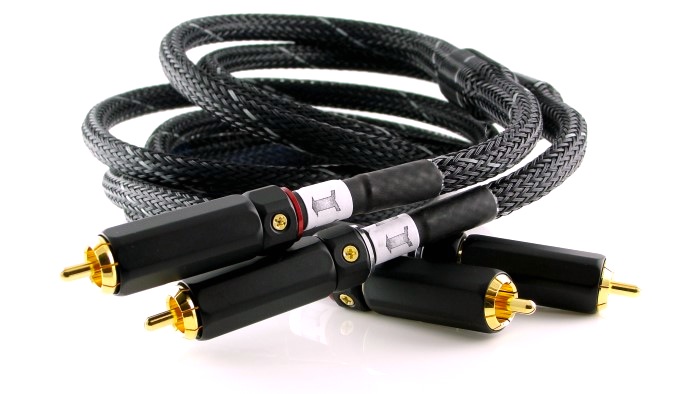
I wrote about Graham Slee’s UK-made Revelation M phono stage with selectable treble-cut and bass-boost controls (which enable proper playback of non-RIAA as well as RIAA 33 rpm records—and also most electrically-cut 78 rpm discs) here.
Bruce Kohl, facilitator of Graham Slee’s US in-home trial program, included a pair of Graham Slee’s Lautus analog line-level signal cables (with locking RCA phono-plug terminations at both ends–other terminations optional) in the package with the phono stage.
When listening for reviewing I try to avoid (if at all possible) changing more than one variable at a time. So, I had to put Slee’s interconnects aside; and, put-aside they stayed. I eventually did listen; but since you are reading this, you likely figured that out already. The story continues after the jump! Continue Reading →


